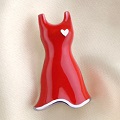Sarah Temple (BA 1987 Woodsworth) has worked in marketing and branding all her career and is currently executive director of communications and marketing at Simon Fraser University. But she’s still proud of the project she calls “a professional and personal highlight” – the iconic The Heart Truth campaign. In just ten years, Temple and her team changed how the world viewed heart disease: re-energizing research, doubling awareness, and yes, saving lives. Here’s how it all began.
Almost 15 years ago, Temple was a senior vice-president at Ogilvy Public Relations Worldwide in Washington DC. The National Institutes of Health, an American government agency, hired Ogilvy to develop a social marketing and communications campaign that would reposition heart disease as a women’s issue too. Naturally, Temple and the team started off with some data gathering – only to find a tough road lay ahead.
Most women then were completely unaware that heart disease was the most common cause of death for both genders (it’s now second, after cancer). “Women did not believe heart disease was a risk that they held personally,” says Temple. “They thought of it as something that affected the men in their lives.”
 The team brainstormed ideas for an icon for the campaign, a rallying image or slogan that would stick in people’s minds. “Our creative director developed a red dress image,” says Temple. “It was a way of portraying heart disease in women and conveying the fact that heart disease was not simply a man’s issue.” They tested a range of creative concepts to see which seemed the most motivating – the Red Dress was the clear winner.
The team brainstormed ideas for an icon for the campaign, a rallying image or slogan that would stick in people’s minds. “Our creative director developed a red dress image,” says Temple. “It was a way of portraying heart disease in women and conveying the fact that heart disease was not simply a man’s issue.” They tested a range of creative concepts to see which seemed the most motivating – the Red Dress was the clear winner.
That’s when Temple’s efforts really began. Responsible for the campaign’s partnership strategy, she connected with corporate partners such as Diet Coke, with media companies and community groups. “It was unbelievable, and so gratifying to see the many ways that the Red Dress was adopted,” says Temple. “Community grassroots activities saw everyone from high schoolers to women in their 80s adopting the Red Dress.”
And then, the fashion industry came on board. In 2003, 19 American fashion designers, including such big names as Vera Wang and Oscar de la Renta, showed custom-designed red dresses in support of the campaign at New York Fashion Week. Before long, celebrities were modelling the dresses each year at the campaign’s signature Red Dress Collection event at Fashion Week, and The Heart Truth was squarely on the nation’s radar. Seven U.S. First Ladies donated real red dresses to be part of various exhibits and a National Wear Red Day observance was launched.
“The Red Dress was a way of portraying heart disease in women in a holistic way,” says Temple. The Heart Truth didn’t just raise awareness with the public, but “it galvanized and renewed the energy of many who had been working in the women’s heart health field.”
The real measure of The Heart Truth’s success, though, was its impact on women’s lives. “Not only did awareness double in the roughly 10 years that the campaign was in the marketplace,” says Temple, “we also had data that showed significant behaviour change. Women were taking action around their heart-healthy behaviours – eating well, increased physical activity, managing blood pressure, cholesterol, etc.” The Heart and Stroke Foundation of Canada joined the campaign in 2008 and it’s also been adopted in Argentina and the UK, says Temple. “It’s amazing to see the kind of appeal that it’s had beyond our early imagination and goals.”






No Responses to “ The Heart Truth ”
U of T should host an orange shirt day!